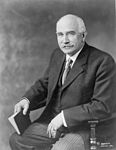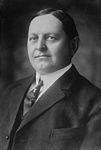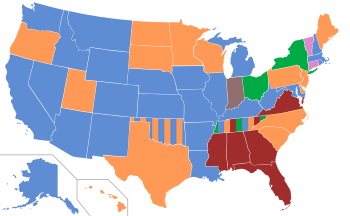
The 1908 United States presidential election was the 31st quadrennial presidential election, held on Tuesday, November 3, 1908. Secretary of War and Republican Party nominee William Howard Taft defeated three-time Democratic nominee William Jennings Bryan.
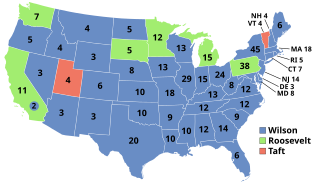
The 1912 United States presidential election was the 32nd quadrennial presidential election, held on Tuesday, November 5, 1912. Democratic Governor Woodrow Wilson unseated incumbent Republican President William Howard Taft and defeated former President Theodore Roosevelt, who ran under the banner of the new Progressive or "Bull Moose" Party. This is the most recent presidential election in which the second-place candidate was neither a Democrat nor a Republican. This is the most recent election to date in which four candidates received over five percent of the vote.

The 1920 United States presidential election was the 34th quadrennial presidential election, held on Tuesday, November 2, 1920. In the first election held after the end of World War I and the first election after the ratification of the Nineteenth Amendment, Republican Senator Warren G. Harding of Ohio defeated Democratic Governor James M. Cox of Ohio.

James Beauchamp Clark was an American politician and attorney who represented Missouri in the United States House of Representatives and served as Speaker of the House from 1911 to 1919.

Judson Harmon was an American Democratic politician from Ohio. He served as United States Attorney General under President Grover Cleveland and later served as the 45th governor of Ohio.
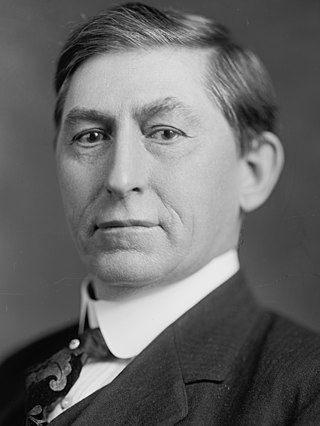
John Burke was an American lawyer, jurist, and political leader from North Dakota who served as the 10th governor of North Dakota from 1907 to 1913, and later served as the 24th treasurer of the United States under President Woodrow Wilson. Following his term as treasurer, he subsequently served intermittently as Chief Justice of the North Dakota Supreme Court first from 1929-1931, then from 1935 until his death in 1937.
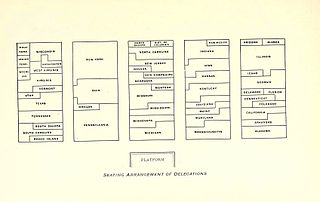
The 1896 Democratic National Convention, held at the Chicago Coliseum from July 7 to July 11, was the scene of William Jennings Bryan's nomination as the Democratic presidential candidate for the 1896 U.S. presidential election.

The 1912 Republican National Convention was held at the Chicago Coliseum, Chicago, Illinois, from June 18 to June 22, 1912. The party nominated President William H. Taft and Vice President James S. Sherman for re-election for the 1912 United States presidential election.
The 1920 Democratic National Convention was held at the Civic Auditorium in San Francisco, California from June 28 to July 6, 1920. It resulted in the nomination of Governor James M. Cox of Ohio for president and Assistant Secretary of the Navy Franklin D. Roosevelt from New York for vice president. The 1920 Democratic National Convention marked the first time any party had held its nominating convention in a West Coast city.
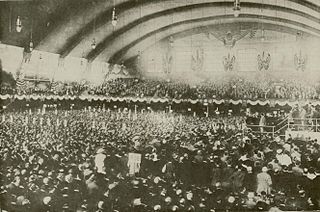
The 1912 Democratic National Convention was held at the Fifth Regiment Armory off North Howard Street in Baltimore from June 25 to July 2, 1912.
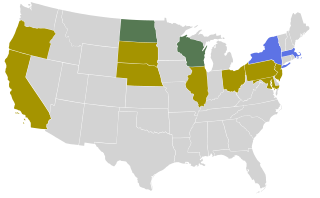
From March 19 to June 4, 1912, delegates to the 1912 Republican National Convention were selected through a series of primaries and caucuses to determine the party's nominee for President in the 1912 election. Incumbent President William Howard Taft was chosen over former President Theodore Roosevelt. Taft's victory at the national convention precipitated a fissure in the Republican Party, with Roosevelt standing for the presidency as the candidate of an independent Progressive Party, and the election of Democrat Woodrow Wilson over the divided Republicans.

Roger Charles Sullivan, was a member of the Cook County Democratic Organization during the early twentieth century.

The 1910 New Jersey gubernatorial election was held on November 8, 1910. Democratic nominee and future President Woodrow Wilson defeated Republican Assemblyman Vivian M. Lewis with 53.93% of the vote. During the campaign, Wilson underwent a political transformation from a symbol of conservative Wall Street reaction into one of the leading members of his party's progressive faction. His victory was widely understood to be the prelude to his campaign for the presidency in 1912.

From March 9 to June 5, 1920, voters of the Democratic Party elected delegates to the 1912 Democratic National Convention, for the purposing of choosing a nominee for president in the 1920 United States presidential election.
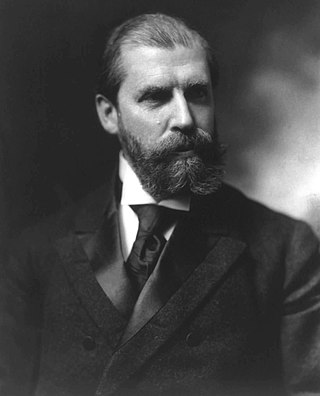
From March 7 to June 6, through a series of primaries and caucuses, voters of the Republican Party elected delegates to the 1916 Republican National Convention, held June 7 to June 10, 1916, in Chicago, Illinois to choose the party's nominee for President of the United States. The delegate election process was inconclusive, with a small plurality supporting Associate Justice of the Supreme Court Charles Evans Hughes. Hughes eventually secured the nomination on the third ballot.

The 1912 United States presidential election in Wisconsin was held on November 5, 1912 as part of the 1912 United States presidential election. State voters chose 13 electors to the Electoral College, who voted for president and vice president.
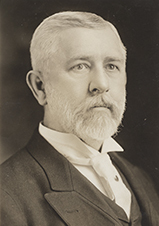
John Thomas Watkins was an American lawyer and politician who served eight terms as a U.S. representative for Louisiana's 4th congressional district.
This is the electoral history of Thomas Woodrow Wilson, a Democrat, who served as the 28th President of the United States (1913–1921), and earlier as the 34th Governor of New Jersey (1911–1913).


